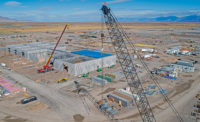...the governor-elect believes that 90% of jobs will go to Illinoisans under the PLA. He also believes that PLAs drive up the cost of doing business,” says Tim Albrecht, communications director for the governor-elect.
Although the revocation could affect future projects, experts don’t think it will affect PLA projects already in progress, including a women’s maximum-security prison in Mitchellville; that contract is expected to be awarded in December.
PLA proponents say that agreements between the project’s labor unions and the state make projects run more smoothly and on schedule by helping with coordination and minimizing disputes. “The PLA eliminates the possibility of jurisdictional disputes, slowdowns, and strikes. It also coordinates the work of different trades to be sure the project moves along,” says Iowa DAS Director Ray Walton, who negotiated the PLA for the Ft. Madison prison project with union leaders.
“Having a standard set of holidays, uniform work hours and safety requirements makes things run more smoothly,” Walton adds. “We’ve also set up a joint advisory committee that will meet monthly to help head off any potential problems.”
Opponents, such as the Master Builders of Iowa, say the construction industry already has well-established methods for resolving jurisdictional disputes and that PLAs actually drive up the cost of projects by cutting down the number of contractors willing to bid. “PLAs actually make projects more complicated than they need to be, and they chill the bidder pool by discouraging some non-union contractors from bidding,” says Master Builders President and CEO Scott Norvell. “If a contractor has an open shop, it sometimes doesn’t want to deal with the complications of a union project, so they just don’t bid. Having fewer bidders cuts down competitiveness and results in higher bids, especially in a hyper-competitive market like today’s.”
Adds Weitz Executive Vice President Mike Tousley, “We’re a union contactor, so we’re in favor of PLAs. But as an Iowa taxpayer, I’m not convinced they’re good things for taxpayers.”
The Bottom Line: Jobs and Money
Much of the contention over the preference issue and the PLA comes down to jobs and whether Iowa taxpayers’ money will stay in Iowa or go elsewhere.
Mick Friedel, president of the Southeast Iowa Building and Construction Trades Council (SIBTCT), who heads the labor side of the Ft. Madison PLA, says he expects about 90% of the jobs on the project to be filled by Iowans. That’s important in southeastern Iowa, where Friedel estimates that about 20% of construction workers are currently unemployed.
“The PLA is a very good thing,” he says. “It assures that wherever the contractor is from, the workforce will be hired from the community.” He also notes that the PLA ensures that qualified non-union laborers can get onto the union hall’s out-of-work list in order to work on the PLA project.
Friedel says that for the site preparation phase of the Ft. Madison project, which started in April and is just being completed, more than 80% of the workers came from Iowa. He expects Iowans will make up 80% to 90% of the workforce throughout the project, and says the project management team will file weekly reports so the state can keep track.
The Master Builders’ Norvell isn’t so certain. “Only about 35% of the contractors on the subcontractors list are from Iowa,” he says. “So how will the project maintain a high number of Iowa workers?”



Post a comment to this article
Report Abusive Comment